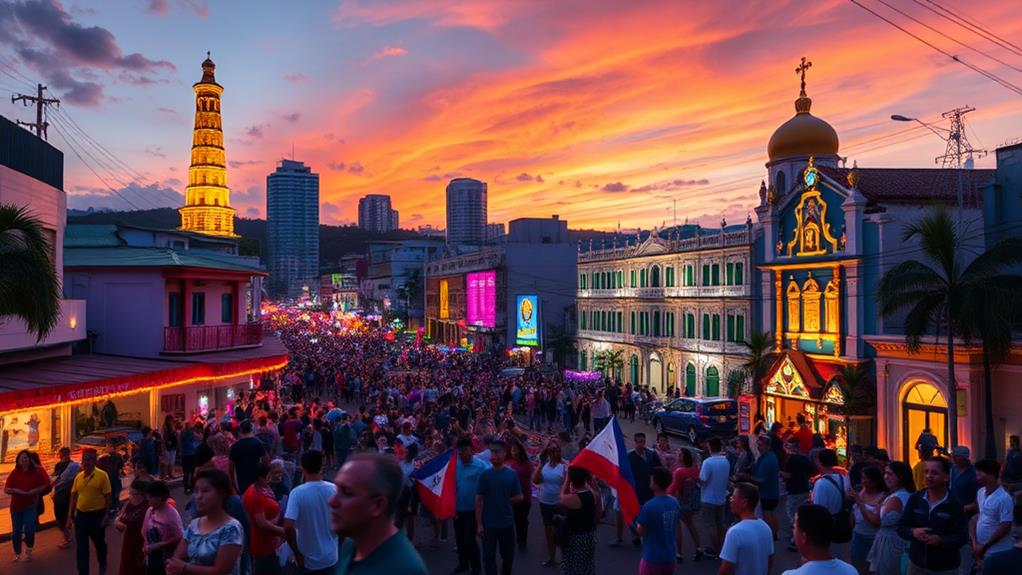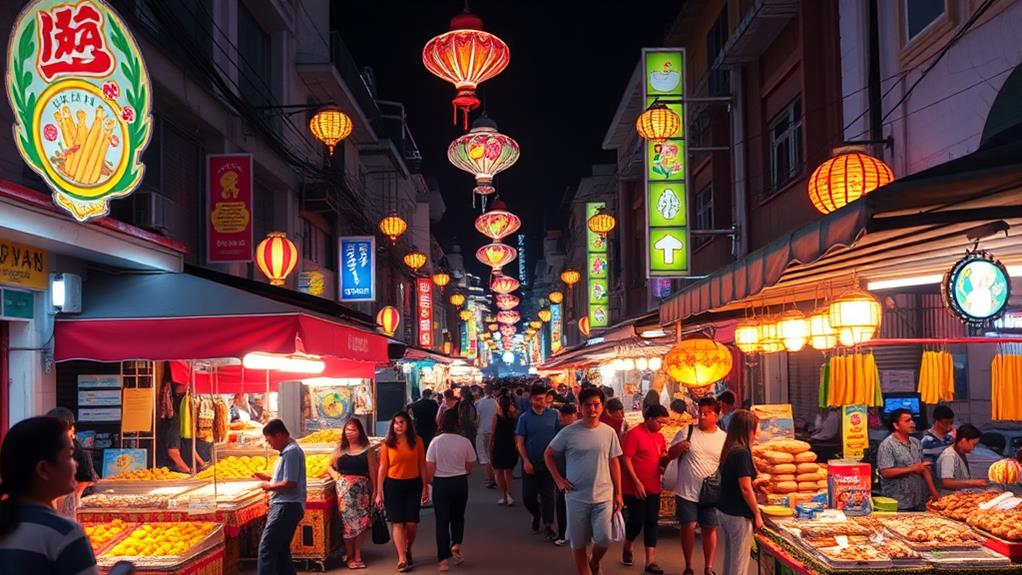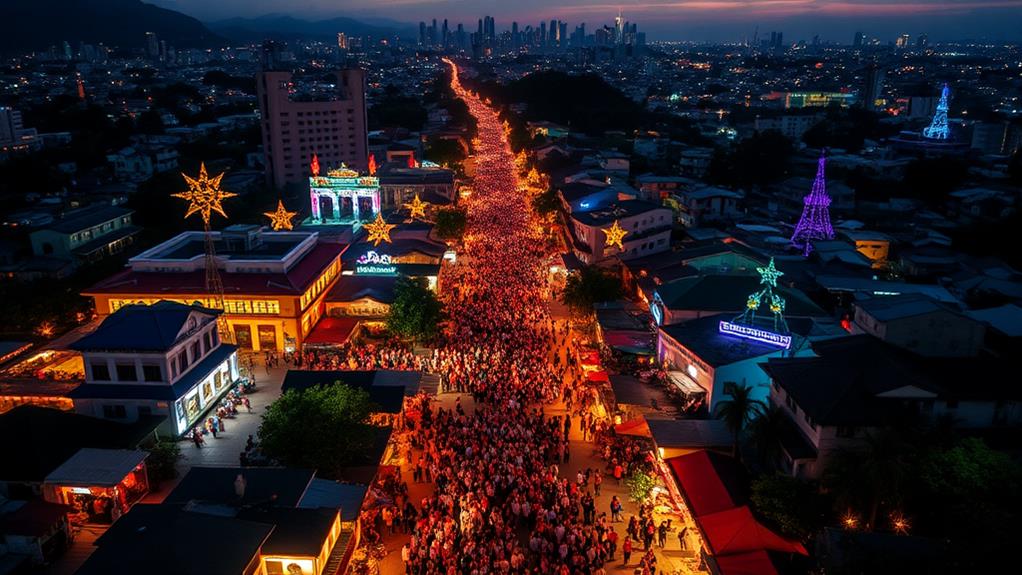The Philippines is home to numerous vibrant celebration hotspots, with cities hosting various festivals throughout the year.
Cebu City has the highest festival frequency and attendance, with its iconic Sinulog Festival drawing 1 to 2 million visitors each January.
Iloilo City's Dinagyang Festival and Bacolod City's MassKara Festival are also popular, showcasing unique traditions and customs with thousands of attendees each year.
These events offer a glimpse into the country's rich cultural heritage, with each one providing a standout experience.
Other notable celebration hotspots in the Philippines include Davao City's Kadayawan Festival and San Fernando City's Giant Lantern Festival.
These festivals attract thousands of visitors and provide a platform for locals to showcase their traditions and customs.
Top Festival Cities in Philippines

The Philippines is home to numerous vibrant cities known for their unique festivals, attracting millions of visitors each year.
Cebu City is a top destination for festival-goers. The city is renowned for the Sinulog Festival, celebrated annually on the third Sunday of January and recognized as the first famous festival in the Philippines. This event draws a massive crowd of 1 to 2 million visitors.
Another hotspot for festivals is Iloilo City, which hosts the Dinagyang Festival every fourth Sunday of January. The festival features street dancing and cultural showcases in honor of the feast of the Infant Jesus, drawing large crowds.
Bacolod City is famous for the MassKara Festival, held every fourth Sunday of October. The festival features colorful masks and street dancing with thousands of participants and spectators each year.
Some cities celebrate their festivals to honor their agricultural bounty and indigenous culture. For instance, Davao City celebrates the Kadayawan Festival in August to honor these aspects.
In contrast, San Fernando City in Pampanga is known for the Giant Lantern Festival, held in December. This competition showcases giant lanterns and attracts many attendees who celebrate the holiday spirit.
These cities offer unique experiences that showcase the Philippines' rich cultural heritage, making them must-visit destinations for festival enthusiasts.
Factors Affecting Festival Attendance
Festival Attendance Factors
Several factors contribute to the success of festivals in the Philippines. These factors shape the overall experience for millions of attendees and can be broadly categorized into economic, cultural, and seasonal factors.
Economic Factors
Economic factors significantly impact festival attendance.
Well-developed local tourism infrastructure and promotional efforts can boost attendance. For instance, the Sinulog Festival in Cebu attracts 1 to 2 million attendees each year due to the city's well-developed tourism infrastructure. This infrastructure allows for easy access to accommodations, transportation, and amenities, making it an attractive destination for tourists.
Cultural Significance
Cultural significance is another crucial factor in determining festival attendance.
Festivals that showcase local heritage and traditions often draw significant crowds. The Dinagyang Festival in Iloilo is a prime example of this, as it showcases the city's rich local heritage and attracts a large number of attendees.
Seasonal Timing
Seasonal timing also plays a key role in festival attendance.
Festivals held during peak tourist seasons or holidays often see higher participation. The MassKara Festival in October, which coincides with the local harvest season, is an example of how seasonal timing can impact attendance. The festival's timing allows attendees to experience the local culture and traditions during a peak tourist season.
Festivals Boosting Local Economy

Festivals in the Philippines significantly contribute to local economies. They transform cities into vibrant hubs of activity that attract millions of visitors each year. For instance, the Sinulog Festival boosts local businesses' sales, generating substantial revenue for vendors and artisans.
Festivals also create job opportunities and enhance community livelihoods. The Dinagyang Festival in Iloilo City is a prime example, where local businesses experience a surge in sales of food, crafts, and accommodations. This growth benefits the local agricultural sector and promotes food tourism, crucial for regional economic sustainability.
Local festivals serve as platforms for showcasing regional products. The MassKara Festival in Bacolod City and the Kadayawan Festival in Davao City draw thousands of participants and spectators, contributing millions to the local economy.
These festivals promote the sale of indigenous products, resulting in increased income for farmers and artisans involved.
By attending these festivals, visitors directly benefit the local economy. They support tourism and experience the rich cultural heritage of the Philippines. This contributes to regional economic sustainability, making festivals a vital part of the country's economic growth.
How do Festivals in Philippine Cities Contribute to Local Economies?
The economic impact of festivals in Philippine cities is substantial. These celebrations draw in tourists, stimulate local businesses, and boost the sale of local products. The influx of visitors leads to higher demand for accommodations, food, transportation, and souvenirs, providing a significant economic boost to the host communities.
Cultural Significance of Philippine Festivals
The Philippines' vibrant festivals offer a glimpse into the country's rich cultural heritage. Over 42,000 major and minor festivals take place annually, allowing visitors to experience the nation's diverse local traditions.
Festivals in the Philippines celebrate the country's cultural heritage by showcasing regional products and agricultural bounty. The Dinagyang Festival and the Kadayawan Festival promote local pride and cultural identity by highlighting regional products. For instance, the Dinagyang Festival in Iloilo City showcases the region's famous coffee, while the Kadayawan Festival in Davao City features its fruits and flowers.
Festivals also feature vibrant parades and tribal dances. The Ati-Atihan Festival honors the Child Jesus in a colorful and lively way. This festival in Kalibo, Aklan, includes parades and street dancing, as well as costumes and tribal dances that reflect the region's cultural heritage.
Festivals bring communities together, celebrating their shared history and traditions through music, dance, and food. The Sinulog Festival in Cebu City attracts millions of visitors each year, making it a significant economic driver for the country.
Ranking the Festival Hotspots

The Philippines hosts thousands of festivals each year, with some cities standing out as top festival hotspots. These cities include Cebu City, Iloilo City, Bacolod City, Davao City, and San Fernando City.
Cebu City is one of the most popular festival destinations, with its Sinulog Festival attracting 1 to 2 million visitors every January. This festival showcases the city's vibrant culture and rich heritage.
Iloilo City follows closely, boasting a rich cultural heritage and thousands of attendees at its Dinagyang Festival, also celebrated in January. This festival highlights the city's unique traditions and customs.
Bacolod City hosts the MassKara Festival in October, a spectacle known for its colorful masks and street dancing. This festival is a must-visit for anyone looking to experience the city's vibrant culture.
Davao City's Kadayawan Festival in August showcases the region's agricultural bounty and indigenous culture, drawing thousands of participants and spectators. This festival is a great way to experience the city's unique cultural heritage.
San Fernando City rounds out the top festival hotspots with its Giant Lantern Festival in December, featuring a competition of elaborate lanterns and parades that draw significant local and international attendance. This festival is a must-visit for anyone looking to experience the city's vibrant culture and traditions.
These cities are a must-visit for anyone looking to experience the Philippines' unique cultural celebrations.
Questions and Answers
Which Is the Most Attended Festival Celebration in the Philippines?
The Sinulog Festival in Cebu City is the most attended festival in the Philippines. This festival attracts 1-2 million visitors annually, showcasing the country's rich cultural heritage. The Sinulog Festival successfully blends cultural significance with local traditions, economic impact, and artistic expression, making it a unique and captivating event.
What Is the Top 1 Festival in the Philippines?
The Sinulog Festival is the top festival in the Philippines. It is a vibrant celebration honoring Santo Niño, a highly revered Catholic icon in the country. This grand festival outshines other notable festivities like Ati Atihan, Pahiyas, and Panagbenga with its unique cultural activities and grand street dancing.
What Is the Festival Capital of the Philippines?
Cebu City is the Festival Capital of the Philippines. This title is due to the city's numerous vibrant events that take place throughout the year. One notable example is the Sinulog Festival, which showcases local culture, food, and stunning festival costumes, and encourages community involvement.
What Is the Largest Festival in the Philippines?
The Sinulog Festival in Cebu City is the largest festival in the Philippines. The festival showcases the city's rich cultural heritage and historical significance through its vibrant traditions and massive community involvement. This event showcases colorful festival preparations and a display of the city's artistry and creativity, drawing in large crowds from across the country.